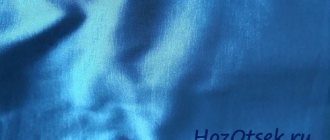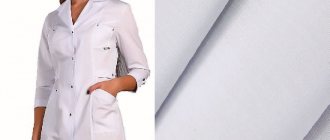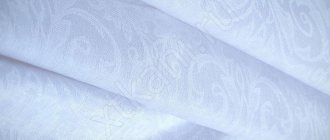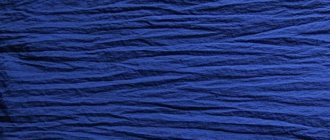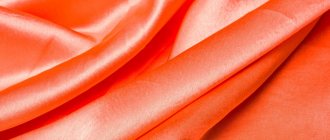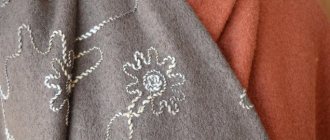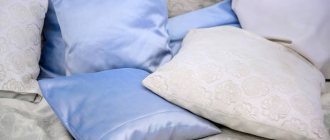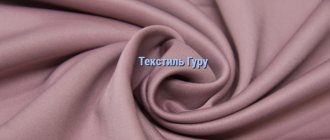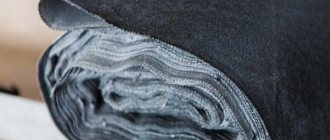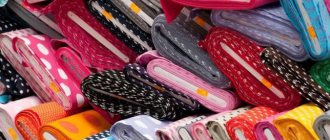This amazing material allows you to create not only luxurious models of evening dresses, but also magnificent everyday items, as well as formal and unusual interiors in any style.
Taffeta was popular in the Byzantine Empire, and then in most European countries in the 19th century, when using crinoline. It was from this material that it was possible to create voluminous silhouettes and spectacular draperies.
Description and characteristics
Taffeta fabric has a plain weave and is made from tightly twisted warp and weft threads, due to this it has the following properties:
- high dimensional stability;
- good water repellency;
- excellent drapability;
- high strength;
- durability;
- high shedding of threads;
- glossy shine.
Fabric production
Not many people know what taffeta is from the point of view of textile production, since the name of the material is very unusual. Translated from Persian it means “woven”. The production of this type of fabric has several distinctive features:
- The threads are twisted and tightly woven together.
- Linen or cotton fibers are used.
- Synthetic threads can be used.
- Before weaving, the threads are heated very much so that after cooling they lie even more tightly.
Until 1990, taffeta had to be woven by hand, as uniform weaving and twisting of the threads could only be achieved with this method. And in 1991, a machine for the production of “royal” textiles was introduced in India.
Note! Well-known exporters are also Germany, England and France. These countries use Indian production technologies.
Various options for manufactured samples
Currently, this country remains the main supplier of taffeta to many countries around the world. The quality of Indian goods exceeds the capabilities of many European manufacturers, since the machines for producing the material operate in accordance with the manual operating principle.
Characteristics table
| Characteristic | Indicators |
| Compound | Cotton; silk; viscose; polyester |
| Density | from 50 to 300 g/m. |
| Width | 90; 150; 280 cm |
| Weave | Polotnyanoye |
| Hygroscopicity | Depending on the composition |
| Thermal conductivity | Bad |
| Fabric shrinkage | In natural species 3-5%; synthetics do not shrink |
| Antistatic | For polyester types - no |
| Stain resistance | good |
| dimensional stability | Excellent |
| Drapability | good |
| Stretch | Absent |
| Pillability | Not exposed |
Compositions and corresponding types
Taffeta can consist of both natural fibers and synthetic and mixed fibers. Each type of composition affects the general characteristics of the fabric - drape, density, appearance.
Natural
Made from natural silk threads, it has a noble shine and beautiful appearance. This material is expensive and increasingly rare.
Cotton - made from natural, plant fiber. The fabric has the same shine but drape better than its predecessor.
Artificial
Viscose is made from fibers of plant origin - cellulose. Pleasant to the tactile sensation, wrinkles a lot.
Acetate - produced from threads of plant origin - cellulose acetate. It has a similar appearance to silk, but is cheaper.
Synthetic
Synthetic - made from polyester or polyester high-molecular compounds. This type is increasingly found in stores, due to the low cost and ease of care of the material, in contrast to natural and artificial types.
Mixed
Blended - made from synthetic and natural fibers. At the same time, the material takes the best qualities of both types. Thanks to polyester, taffeta wrinkles less and becomes more wear-resistant. Natural components in the composition give a pleasant tactile sensation.
History of taffeta
Taffeta Dress
In Persian, the word taffeta is an adjective that means woven material. In Europe, crinolines and petticoats were made from taffeta. Foreign fabric came to Russia only in the 14th century. The material was brought from enlightened Byzantium and exotic Asia. Caftans and trousers, sundresses, and smart men's shirts were made from taffeta. It was used to trim fur coats and hats - the fabric was used as a lining and an independent material.
Before the invention of synthetic fibers, taffeta was made only from cotton and silk. Then they began to use materials created using chemical reactions - inexpensive, reliable, durable fibers.
For a long time, taffeta was made by hand, until at the end of the twentieth century in the Indian city of Bangalore, a special machine for this type of fabric was invented. The best samples of matter are supplied by England, Italy and France.
Interesting fact: waxed or silk taffeta was used to create balloons (aerostats). The wings of the first Russian aircraft, designed by A.F. Mozhaisky, were also covered with this material.
Varieties
Plain (plain colored) - the warp and weft threads have the same color.
Printed - various designs are applied to the plain-dyed fabric.
Shanzhan (changing) - the warp and weft threads are painted in different colors, due to this the taffeta shimmers when the lighting angle changes.
Types by texture
- Smooth - with a regular plain weave, it has a slight sheen.
- decorative - with various volumetric finishes in the form of appliqués, sequins or other decorative elements.
- Crash - a compressed surface is achieved by thermal pressing.
Curtains in the interior
Taffeta, as a fabric for curtains and curtains in window decoration, is used in cases where it is necessary to add solemnity to the interior and create an elegant atmosphere. In those rooms where the curtains in the classic version do not correspond to the overall style, taffeta is used as Roman blinds. This is permissible, since the material has the necessary strength. For this type of curtains, it is better to choose plain or striped fabrics.
The sensuality and airiness of the material are emphasized by the play of colors, which would be appropriate in the living room, nursery, bedroom or kitchen. The fabric itself is so self-sufficient and interesting that complex additional decor is not even needed.
Living room
For the living room, you can pay attention to the very beautiful “chameleon” fabric. How advantageous a curtain made of iridescent taffeta will look in the interior largely depends on the lighting. The play of fabric shades shows itself most clearly in good light, artificial or natural.
By hanging such a curtain using eyelets, you can not only complement the interior, but also endow it with features of sophistication. The property of taffeta to drape well can be actively used in decoration.
Advice! For a classic living room design, it is advisable to choose taffeta in light pastel shades.
Home office
Synthetic dense material will give the office the necessary rigor and formality. At the same time, the atmosphere will not be overly boring. Taffeta with flock is the most suitable option.
Kitchen
For the kitchen, it is better to choose taffeta curtains that are bright and shiny. Such color solutions will create the mood and highlight the window.
Bedroom
In a double-layer version, a taffeta curtain will best fit into the bedroom interior. For such curtains, the base is thick fabric, and the second layer is light silk. Combined with organza, taffeta will look lighter, creating a romantic atmosphere.
For windows that are oriented to the south, the design is often complemented by roller blinds. The high density of the fabric will reliably shade the room, creating the necessary conditions for relaxation.
Where is it used?
Thanks to its properties, taffeta can be used to model three-dimensional shapes without adding weight to the structure. Therefore, products made from it look spectacular and airy.
Both wedding and everyday dresses are made from taffeta. Due to their properties, products made from the material look very luxurious. Also, this fabric has found its application in curtains; thanks to its characteristics, taffeta curtains look very elegant.
Application area
Taffeta is used in the following industries:
- light industry.
Used for sewing evening dresses (dresses, suits, skirts, blouses, stoles), stage costumes (sports, carnival, theater);
- furniture manufacturing.
Used as upholstery for upholstered furniture;
- production of home textiles.
It is used for sewing curtains, decorative pillows, bedspreads, and decorative elements.
Recommendations for caring for taffeta products:
- We recommend careful hand or machine washing in a delicate cycle at a water temperature of no higher than 30 degrees C;
- It is better to use liquid detergents for washing delicate fabrics;
- do not use aggressive detergents;
- spinning in the washing machine is prohibited;
- manually wring out carefully, without twisting the product or squeezing it, wrap it in a towel, absorb excess water and straighten it horizontally. Be sure to cover the top with a dry cloth. Dresses and skirts can be dried on hangers, carefully straightening the product;
- dry away from heating devices;
- iron at the lowest possible temperature, only on the wrong side;
- Clothes should be stored on hangers in a case, bedspreads and curtains neatly folded. Storage in vacuum bags is unacceptable.
Photos of fabric
© 2021 textiletrend.ru
What to consider when cutting
If you decide to use taffeta to realize the desired model, do not forget what kind of fabric this noble taffeta is! It requires special treatment when cutting, sewing and further use of the product.
When cutting, the details of a paper pattern must be pinned to the fabric only with very sharp tailor's pins. Immediately after cutting, you need to iron non-woven strips cut on the bias to the seam allowances. This will prevent the threads from moving apart in the seams.
When sewing parts, use only sharp needles No. 70 or 80 and polyester threads. Stitch length 2 – 2.5 mm.
Expert opinion
Alyona
Fabric expert and technologist Alena Khlebnikova is ready to answer your questions.
Write to us
or leave feedback to our expert
How much does the material cost?
The cost of fabric from the manufacturer, the store’s pricing policy, materials and manufacturing method. On average, the price varies from 150 to 500 rubles. For taffeta made from natural silk you will have to spend more than 1000 rubles per 1 sq. m. m.
Taffeta is a glossy fabric that is woven using plain technology from highly twisted fibers. This ensures the strength and lightness of the material. It is used for sewing festive clothes, home textiles, and furniture upholstery.
Historical excursion on fabric:
Do you think it is acceptable to use taffeta for sewing casual clothes? Share your tips for working with fabric in the comments. Save the article to bookmarks or repost it on social networks.
